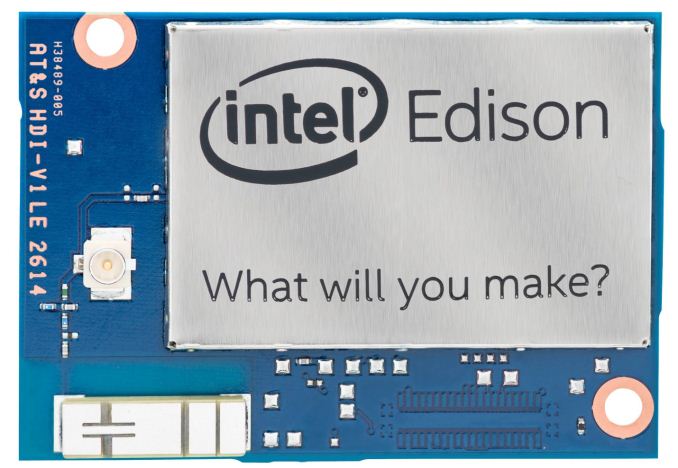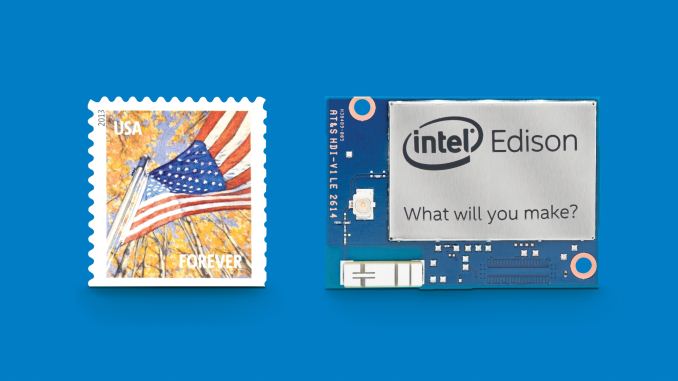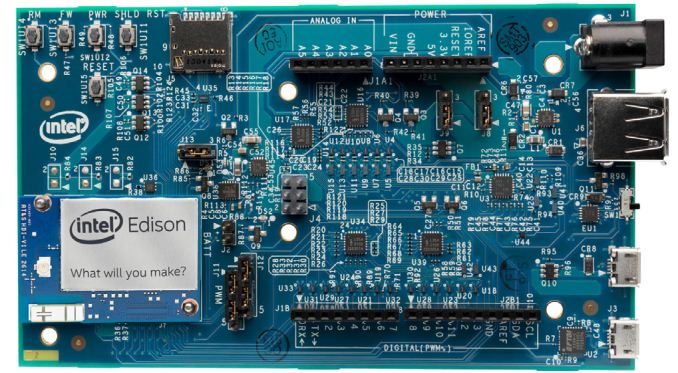IDF 2014: Intel Edison Development Platform Now Shipping
by Ryan Smith on September 9, 2014 8:00 PM EST
As part of today’s IDF 2014 keynote, Intel has announced that their Edison development platform is now shipping.
First announced back at CES, Edison is a development platform for Intel’s burgeoning Internet of Things development initiative. At just over a postage stamp in size and containing a dual-core Atom CPU and a Quark CPU, Intel is hoping to jump-start development of tiny internet-connected x86 devices by providing a complete platform for developers to use in their devices. Edison in this sense is closer to a platform on a chip than a system on a chip; it not only contains the processors and RAM, but also the wireless components, right on down to the antennas.
| Intel Edison Development Platform | |
| CPU |
Dual-Core Silvermont Atom @ 500MHz + Quark @ 100MHz |
| RAM | 1GB LPDDR3 (2x32bit) |
| WiFi | 2.4/5GHz 802.11a/b/g/n, BT 4.0 |
| Storage | 4GB eMMC |
| I/O | SD + UART + SPI + GPIO + USB 2.0 OTG |
| OS | Yocto Linux v1.6 |
| Dimensions | 35.5 x 25 x 3.9 mm |
Fabbed on Intel’s 22nm process, the Edison platform contains an interesting setup that pairs a dual-core Silvermont Atom that runs at 500MHz with a Quark that runs at 100MHz. The Atom in this sense is the primary processor for the SoC, while the Quark serves as an embedded microcontroller responsible for running other functions on the platform. Intel pairs these processors up with 1GB of LPDDR3 in a 2x32bit configuration and a 4GB of eMMC NAND for storage. Wireless meanwhile is provided by a Broadcom 43340, which offers dual-band 802.11 a/b/g/n and Bluetooth 4.0.
The Edison platform itself can be further attached to additional development boards to expand its functionality and access its I/O. Intel is demonstrating both a simple USB board and a more complex development board. But as Edison offers Arduino compatibility, it can take advantage of the current Arduino development ecosystem.
Finally, Intel tells us that the Edison module itself is expected to retail for around $50. Meanwhile the breakout board kit and the Arduino kits will sell for $60 and $85 respectively.












12 Comments
View All Comments
jeffkibuule - Tuesday, September 9, 2014 - link
A pretty cool board that's perfect for my projects!Ikefu - Tuesday, September 9, 2014 - link
Bring a dual core atom to an Arduino/Raspberry Pi type platform is amazing. I wonder how it compares in terms of single core compute to a Raspberry Pi? Its half the frequency but I'm betting it destroys it in instructions per clock so a comparison would be really neat to see.dragonsqrrl - Tuesday, September 9, 2014 - link
I don't think the raspberry pi is clocked at 1GHz, but even if it were it would probably still get completely steamrolled in terms of performance. It's what, an Arm11 or something?But then again it is priced lower, so you have to take that into consideration.
gngl - Thursday, September 11, 2014 - link
RPi has a slow CPU, but some people apparently managed to run computationally intensive code on the GPU, and that has up to 25 GFLOPS. Now that is a theoretical maximum that you may not reach in many computations, but for example FFT (which is arguably very important for many applications) runs about ten times faster on the GPU: http://www.raspberrypi.org/accelerating-fourier-tr... That sounds like a decent speedup to me! Lack of documentation has been until recently the reason why people couldn't do this in the past.aruisdante - Tuesday, September 9, 2014 - link
Silvermont Atom is roughly on par with a Cortex A9 in terms of CPC performance. So yeah, it's a LOT more powerful.iwod - Wednesday, September 10, 2014 - link
No, Silvermont is better then A15.virtual void - Tuesday, September 16, 2014 - link
Depends on what you do. A15 behaves a bit like an American muscle-car, great in a straight line (few conditional branches, few tree/linked list traversals etc) but kind of lacks in handling.Silvermont absolutely crush A15 in things like
http://benchmarksgame.alioth.debian.org/u32/perfor...
which kind of suggest that Intel is still light years ahead ARM in L2-cache design.
dragonsqrrl - Wednesday, September 10, 2014 - link
I think even the pre-Silvermont Atom architecture (can't remember the name) was a little faster than the Cortex A9.iwod - Wednesday, September 10, 2014 - link
I wonder if they have any PCI-Express connection available. I mean this is perfect for Router/ NAS etc Appliances.coder543 - Wednesday, September 10, 2014 - link
I remember specifically that it was supposed to be a dual core Quark chip... this is disappointing to me. It's a potent accomplishment, no doubt, but programming for a heterogeneous architecture like this won't be as easy as programming on a homogenous system, and multicore microcontrollers are rare enough (though they do exist) that it would have at least filled a niche, but maybe I just don't understand the purpose of this platform.